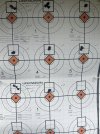I have been working up some loads for my Christensen Arms Mesa 300 PRC with a 1:8 twist barrel. I think I have found something that might work. Barnes 200 LRX with H1000. I had been doing a slight different version of a OCW test. I start my testing almost at minimum, 70.0 grs., and work up in .5 gr. to 75.5. At 75.5, I could hear some crunching as I was seating the bullet. Barnes says min is 69.4 (2644fps) and max is 77.1(2891 fps). I loaded these at book length which is 3.500". Which is about .10" shorter from mag length. Take a look at the attached target. I think I know which load I want to work on. Just want some opinions on what you see. Plus, I'm wondering if it's fast enough for what I am shooting. I haven't ran these through my Magnetospeed so don't know how fast they are. Usually find that after I find a load.
Jason
View attachment 479395
Everyone has their method. But here's mine.
1) I work on the powder/bullet combo. Im looking for a stable node with low Sd/ES.
I would work in .4 to .6 increments, when you find something to explore, you can come back and shoot the .2 or .3 between the .4/.6. IE say you do .6 and like a node between 65.2-65.8 come back and shoot 65.5. Now you have data for the whole range.
target is not really needed, but can provide useful data, chronograph is required.
2) Once I find the powder/ bullet, I test for best primer. Again target not needed, chrono is.
3) do seating depth test. Preferably at 600 yards. But can be done closer.
The seating depth is to tune your load, or change the timing when it exits the barrel. Closer to the lands it exits faster, and pressure/speeds will be faster, farther from the lands, not only does it exit slower, but speeds will also decrease.
it serves no purpose to tune the load and then do your powder and change everything up. You'll end up chasing your tail.
Here's a picture of one of my seating tests. Lost 15 fps, but found a wide seating node that should stay tuned for the life of the barrel.
But…..your not done yet. Now to take it out to distance and verify the load.
Shoot in different weather, ect.
I just had a "great load" fall apart at 1,000 yards in 95 degree weather. Because I skipped the primer test.
Last night I did the primer test in 95 degree weather on 7SAUM/180hybrid.
26 rounds in 15 minutes over .5 grains of powder, combined SD 6.3 - ES 23 and that's with a barrel that was at 159 degrees at the end of the test.
hope this is helpful in someway.


